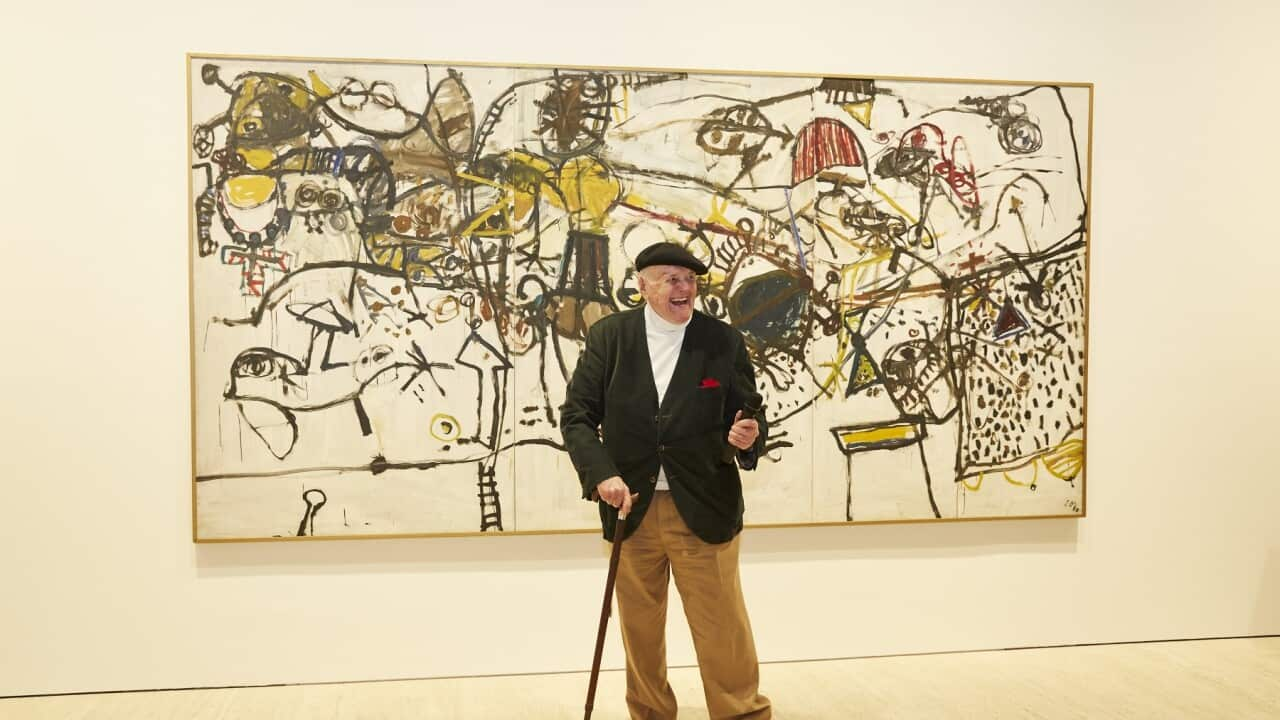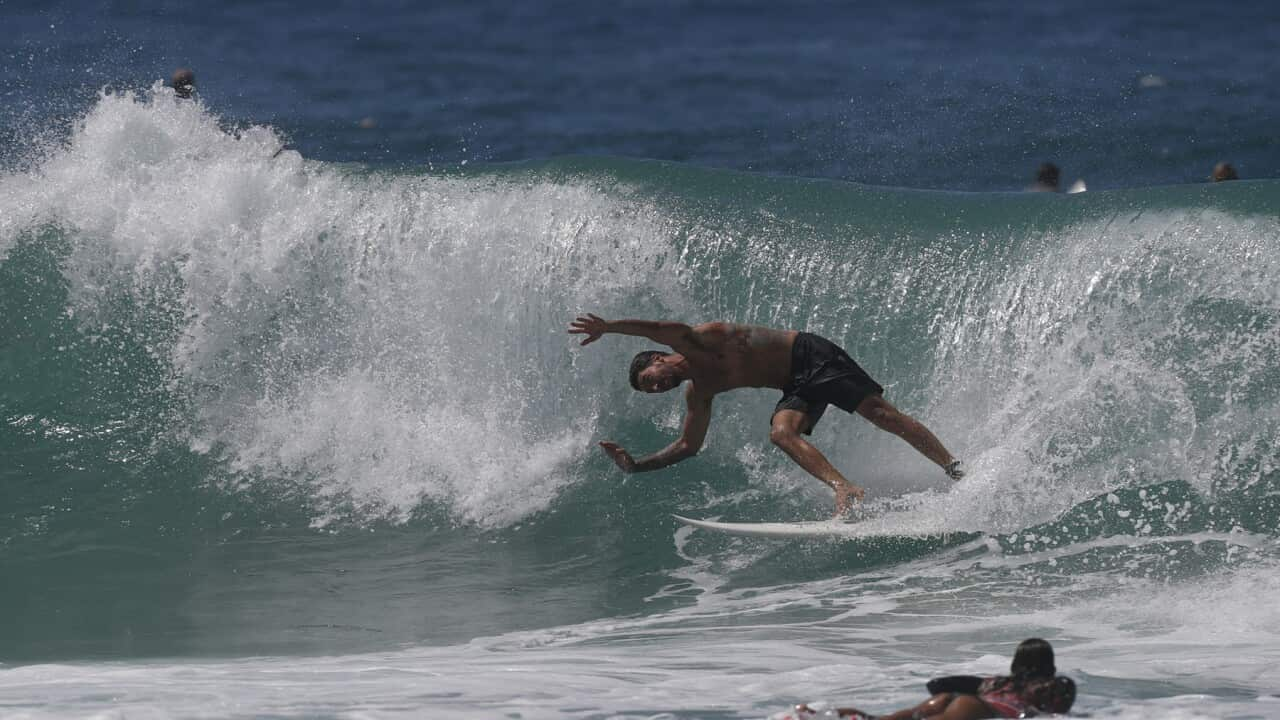English
John Olsen has died at age 95.
A great lover of the "wild" Australian terrain, Mr Olsen has left behind a legacy of distinct Australian landscapes.
"Like to be an Australian writer, poet, you're an explorer. For a young artist, you've got to work out strategies that are going to leave you opportunities to express these fleeting moments. It doesn't matter what anybody tells you, 'Oh I don't like that part of your work'. If you feel it do it. How you feel is important, and feeling makes style."
That was Mr Olsen in 2018.
Heralding a career that spanned more than 60 years, the Newcastle-born painter's work was exhibited in galleries across the nation, and overseas.
The esteemed artist was awarded one of the highest accolades for his work in 1977, an Order of the British Empire, as well as an Order of Australia in 2001 for his exceptional service to the arts.
His son, Tim Olsen, an art gallery owner and author, told has SBS his father was surrounded by family in the New South Wales Southern Highlands upon his death.
"Well there we were at dusk in the effervescent light, looking over the lake from his bedroom. And there he was tucked up, surrounded by flowers and candles, and Eric Satie playing in the distance. And just to see him drift off, with almost a sort of half grin on his face - almost as if 'I did it'."
Head Curator of Australian Art at the Art Gallery of New South Wales, Wayne Tunnicliffe, says Mr Olsen revolutionised Australian art.
"We have lost a giant today of John Olsen, and I think it's sad that that moment has arrived. But I also think it's a celebration of an extraordinary life, and an extraordinary artist. He really is one of Australia's greats. He enabled us to see Australia and see the world in a different way. When he came to the fore form the 1950s onwards, he really invented a new visual language for experiencing our sense of place."
Mr Olsen had an unexpected entry into the art world.
He was born in Newcastle in 1928 and left school at the age of 15 to initially work as a clerk before he became a freelance cartoonist.
According to his son Tim Olsen, John Olsen's father suffered from the war and fell into alcoholism.
John Olsen told the National Gallery of Victoria in 2018 about his early childhood.
"I was reminded by my mother about the age of five that I must stop scribbling in her cook books. I was amazed that she'd even say that. And my father emphasises this problem that the family had. That Esmae, I'm rather concerned that this boy might burst his brains."
It wasn't until 1947 that Mr Olsen commenced formal studies in art at the Datillo Rubbo, before then studying under John Passmore at the Julian Ashton school.
Passmore left a strong impression on Mr Olsen, who he describes as having a profound influence on his drawing.
But it was perhaps his trip to Europe in 1956 that truly awoke Mr Olsen's artistic journey.
"One of the things that really had a very big influence on me, was I went down to Spain, which was very cheap. And there was the Mediterranean, the great tradition of western art, of western philosophy was created. And I've never forgotten it, in fact I wear a beret, which is so that I'm still a Mediterranean person."
It was when Mr Olsen returned from his travels that one of his most acclaimed works emerged.
His 1960 'You Beaut Country' series spoke to a celebration of Australian colloquialism.
Mr Tunnicliffe describes how Mr Olsen's work conveyed a powerful sense of place.
"In the 1950s and 60s when he developed his unique language, most artists were painting still at a representational mode, sharing the world as it appeared. Whereas, he brought in this wonderful sense of evocation, of actually being in the place and experiencing with all your senses, rather than just how it looked. And I think that legacy will continue."
His 'You Beaut Country' series is unique in its ability to capture the Australian landscape from multiple perspectives simultaneously.
Mr Olsen describes in a 2017 Art Gallery of New South Wales interview how he sought to move away from the traditional horizon perspective, and portray Australia in all its unruliness.
"This unique thing of working in this very, very strange continent. A new language, a new way of feeling. A profound sense of understanding, it's unique. And I think when you grasp that sense of being rooted to the earth of Australia becomes a different thing. This is not nationalism, this is understanding."
Prime Minister Anthony Albanese has praised the work of Mr Olsen in a statement on Twitter.
"John Olsen was a giant who never lost the twinkle in his eye. A man of talent, charisma, generosity and humility, he was a poet of the brush, a truly great explorer and interpreter of the Australian landscape. We were so lucky to have him. May he rest in peace."
Italiano
John Olsen è morto all’età di 95 anni.
Un grande amante del territorio selvaggio australiano, Olsen ha lasciato un’eredità di paesaggi australiani inconfondibili.
"Like to be an Australian writer, poet, you're an explorer. For a young artist, you've got to work out strategies that are going to leave you opportunities to express these fleeting moments. It doesn't matter what anybody tells you, 'Oh I don't like that part of your work'. If you feel it do it. How you feel is important, and feeling makes style."
Questo era Olsen nel 2018.
Annunciando una carriera che si è estesa per più di 60 anni, le opere dell’artista nativo di Newcastle sono state esibite nelle gallerie di tutta la nazione e del mondo.
Lo stimato artista è stato premiato con uno dei più alti riconoscimenti per il suo lavoro nel 1977, l’Ordine dell’Impero britannico, così come l’Ordine d’Australia nel 2001 per il suo eccezionale servizio alle arti.
Suo figlio Tim Olsen, gallerista e autore, ha detto a SBS che suo padre era circondato dalla famiglia nelle Higlands nel sud del New South Wales al momento del trapasso.
"Well there we were at dusk in the effervescent light, looking over the lake from his bedroom. And there he was tucked up, surrounded by flowers and candles, and Eric Satie playing in the distance. And just to see him drift off, with almost a sort of half grin on his face - almost as if 'I did it'."
Wayne Tunnicliffe, curatore capo di arte australiana alla galleria d’arte del New South Wales, ha detto che Olsen ha rivoluzionato l’arte australiana.
"We have lost a giant today of John Olsen, and I think it's sad that that moment has arrived. But I also think it's a celebration of an extraordinary life, and an extraordinary artist. He really is one of Australia's greats. He enabled us to see Australia and see the world in a different way. When he came to the fore form the 1950s onwards, he really invented a new visual language for experiencing our sense of place."
Olsen è entrato in modo inaspettato nel mondo dell’arte.
È nato a Newcastle nel 1928 ed ha lasciato la scuola a 15 anni per lavorare inizialmente come impiegato prima di diventare un fumettista indipendente.
A detta di suo figlio Tim, il padre di John ha sofferto dopo la guerra ed è caduto nell’alcolismo.
John Olsen ha parlato della sua prima infanzia nel 2018 alla National Gallery del Victoria.
"I was reminded by my mother about the age of five that I must stop scribbling in her cook books. I was amazed that she'd even say that. And my father emphasises this problem that the family had. That Esmae, I'm rather concerned that this boy might burst his brains."
Ma è solo nel 1947 che Olsen ha iniziato gli studi formali d’arte al Datillo Rubbo, per poi studiare sotto John Passmore alla scuola Julian Ashton.
Passmore ha lasciato una forte impronta su Olsen, che descrisse come una profonda influenza sul suo disegno.
Ma è stato forse il suo viaggio in Europa nel 1956 che veramente risvegliò il viaggio artistico di Olsen.
"One of the things that really had a very big influence on me, was I went down to Spain, which was very cheap. And there was the Mediterranean, the great tradition of western art, of western philosophy was created. And I've never forgotten it, in fact I wear a beret, which is so that I'm still a Mediterranean person."
È stato quando Olsen è tornato dai suoi viaggi che una delle sue più celebrate opere venne al mondo.
La sua serie 'You Beaut Country' del 1960 parlava di una celebrazione dell’informalità australiana.
Il signor Tunnicliffe ha descritto come le opere di Olsen hanno trasmesso un forte senso di spazio.
"In the 1950s and 60s when he developed his unique language, most artists were painting still at a representational mode, sharing the world as it appeared. Whereas, he brought in this wonderful sense of evocation, of actually being in the place and experiencing with all your senses, rather than just how it looked. And I think that legacy will continue."
La sua serie 'You Beaut Country' è unica nella sua abilità di catturare gli ambienti australiani contemporaneamente da diversi angoli.
In un’intervista del 2017 alla Art Gallery del New South Wales, Olsen ha descritto come cercò di abbandonare le tradizionali prospettive orizzontali, per ritrarre l’Australia in tutta la sua sregolatezza.
"This unique thing of working in this very, very strange continent. A new language, a new way of feeling. A profound sense of understanding, it's unique. And I think when you grasp that sense of being rooted to the earth of Australia becomes a different thing. This is not nationalism, this is understanding."
Il Primo Ministro Anthony Albanese ha lodato il lavoro di Olsen con una dichiarazione su Twitter.
"John Olsen was a giant who never lost the twinkle in his eye. A man of talent, charisma, generosity and humility, he was a poet of the brush, a truly great explorer and interpreter of the Australian landscape. We were so lucky to have him. May he rest in peace."




